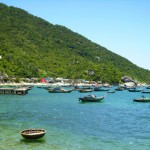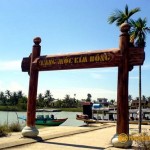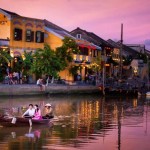The island has become one of 15 Vietnamese maritime reserves since 2007. But, in May, 2009, the United Nations Educational, Scientific and Cultural Organisation (UNESCO) accepted Cham island as a world biosphere reserve thanks to its topography, the biodiversity value and the unspoilt and attractive landscape.
Flora and fauna
Hon Lao island and many of the other islands of the archipelago are extensively forested. According to the Forestry Protection Department of Quang Nam forests covered all islands are natural and extremely protected forests.
Forests in Cu lao Cham play a very important role of water resources protection for the whole islands. Moreover, on the Eastern site of Hon Lao and some other rocky islands such as Hon Co, Hon Ong nest birds (for making “Bird’s Nest Soup”) are harvested & traded.
The island is a place where shelters for value swallow birds. The natural vegetation of the islands is lowland evergreen forest, which is natural with a lot of woods and rare animals.
Scientists report the occurrence of macaques Macaca sp., monitor lizards Varanus sp. and pythons Python sp. To date, 265 vascular plant species have been reported from the nature reserve. Furthermore, a species of swiftlet Collocalia sp. is reported to nest on Hon Kho within the nature reserve.
Cu Lao Cham is also home to salanganes, birds whose nests have long been considered a delicacy by aristocrats and the wealthy. The nests may cost as much as US $4,000 per kilogram. In a beautiful day, tourists are able to see cliffs where salanganes build their nests and talk with salangane-nest takers.
Visiting Cu Lao Cham, you also have chances to view the sea swallows’ nests clinging to the towering cliff. Cu Lao Cham wins kudos for its seafood and delicacies (octopuses, lobsters, fish’s fin, abalone, kaki, hind, cholonia’s eggs, bird’s nests) and fascinating souvenirs (pearls, conches, tortoise-shells).
Marine Ecology
Around the island has a lots of color corals under the water. Situated in a salty-water area, this square-bottom well, amazingly, provides clear fresh water all year round. Enjoyable extras include white-sand, pristine beaches and captivating attractions evocatively named Bai Ong, Bai Bim, Bai Chong, Bai Bac, Suoi Tinh, Cau Mo, Suoi Ong and so on, where tourists can relax, go hunting, fishing even fishing octopuses.
According to the report on marine resources survey conducted by Department of Fisheries, Department of Science, Technology, and Environment of Quang Nam Province and Nha Trang Institute of Oceanography, there are 135 species in 35 genera of corals found around Cu Lao Cham, six species in the sea of Vietnam were first recognized here. There are 202 species in 85 genera and 36 families of fish; and 4 species of lobsters and 84 species of mollusks identified. A recent study found 180 species of hard coral “in generally good condition”. Some species are unique to this region of the East Sea. Popular sightings: Sea stars, trigger fish, baracuda, sea snakes, ribbon eels, rock fish, nudibrachs & many kinds of brightly coloured reef fish. you go for a scuba dive you will encounter a wonderful marine world.
Vietnamese Government together with Danish Government DANIDA funded the Cu Lao Cham Marine Park Administration which created Vietnam’s second marine park. The expected zone for Cu Lao Cham marine protected area (MPA) included eight islands and 5,175 ha of water surface with 165 ha of coral reef, 500 ha of seaweed and sea grass beds, which provide habitat for various valuable fish species.
The water environment around the Cham Islands is an important fishery ground. Several marine products of high economic value, such as lobsters, groupers, snappers, craps, shrimps, and clams, occur in the area. The islands’ coral reefs are an important area for shelter, nursery, and food providing for marine resources.
Moreover, you can take a tour to Lang beach for seeing some interest places as such Au Thuyen-a shelter for boats at bad weather, a 100-year Tay Tang Pagoda remarking the Puddhism that came here for long time ago, Ong temple – a place worshipping a big fish buried here.
Source: Vietnamhotels.com
Joint us at Facebook to get more support!
Proud to be your local guide
Soure: hoian-tourism.com
Post Views:
1,609







